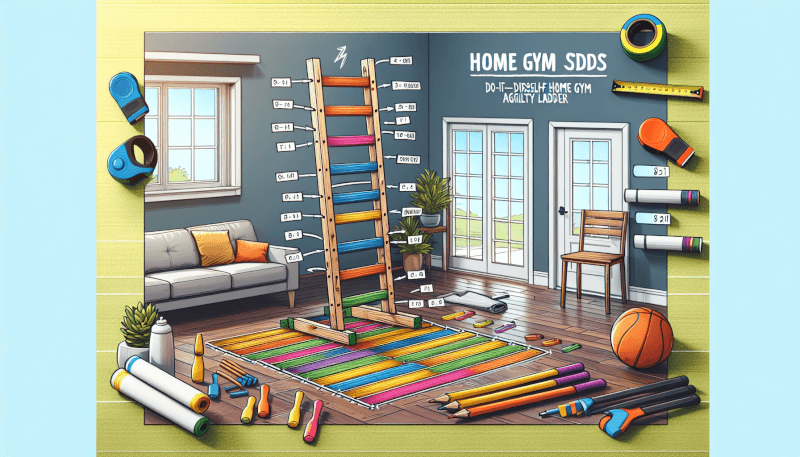Are you tired of spending money on gym memberships and equipment? Look no further! In this article, we will guide you through the process of creating your very own DIY home gym agility ladder. With a step-by-step guide that is easy to follow, you will be able to enhance your speed, balance, and coordination right from the comfort of your own home. Say goodbye to crowded gyms and hello to a fun and effective workout routine. Get ready to unleash your inner athlete and take your fitness journey to new heights!

Materials Needed
To create your own DIY home gym agility ladder, you will need the following materials:
PVC pipes
PVC pipes are the main component of the agility ladder. They are lightweight, durable, and easy to work with. You can find PVC pipes at most hardware stores.
Measuring tape
A measuring tape will be used to determine the desired length of your agility ladder, as well as to measure and mark the PVC pipes.
PVC cutter
A PVC cutter is necessary to cut the PVC pipes to the desired lengths. This tool makes clean, precise cuts and is designed specifically for cutting PVC.
PVC glue
PVC glue is used to secure the PVC pipes together, ensuring the stability and durability of your agility ladder.
Marker
A marker will be used to make accurate measurements and markings on the PVC pipes.
Measuring and Cutting the PVC Pipes
Before assembling the agility ladder, you’ll need to measure and cut the PVC pipes. Follow these steps:
Step 1: Determine the desired length of your agility ladder
Decide how long you want your agility ladder to be. The length can vary depending on your personal preference and the available space in your home gym.
Step 2: Measure and mark the PVC pipes according to the desired length
Using a measuring tape, measure and mark the PVC pipes according to the desired length of your agility ladder. Make sure to make accurate measurements to ensure a properly sized ladder.
Step 3: Cut the PVC pipes using a PVC cutter
Using a PVC cutter, carefully cut the PVC pipes along the marked lines. Ensure that the cuts are clean and straight to ensure a secure fit when assembling the ladder.
Assembling the Agility Ladder
Now that you have your cut PVC pipes, it’s time to assemble the agility ladder. Follow these steps:
Step 1: Lay out the cut PVC pipes on a flat surface
Find a flat surface, such as the floor or a workbench, to lay out the cut PVC pipes. This will make it easier to assemble the ladder.
Step 2: Apply PVC glue to one end of a PVC pipe
Apply PVC glue to one end of a PVC pipe. Be sure to follow the manufacturer’s instructions on how to use the glue properly.
Step 3: Connect the glue-applied end of the PVC pipe to another PVC pipe
Take the PVC pipe with the glue-applied end and connect it to another PVC pipe. Press the two pipes together firmly to ensure a secure bond.
Step 4: Repeat Steps 2 and 3 to connect all the PVC pipes together
Continue applying PVC glue to one end of each PVC pipe and connect them together, repeating Steps 2 and 3 until all the PVC pipes are connected.
Step 5: Allow the PVC glue to dry completely
Once all the PVC pipes are connected, allow the PVC glue to dry completely. This may take up to 24 hours, depending on the type of PVC glue used. Avoid moving or using the ladder until the glue has fully cured.
Optional: Adding Rungs to the Agility Ladder
If you want to add rungs to your agility ladder to create more challenging drills, follow these steps:
Step 1: Measure and mark the desired spacing for the rungs
Using a measuring tape, determine the desired spacing between each rung. Mark these measurements on the side pipes of the ladder.
Step 2: Cut PVC pipes to the desired length for the rungs
Using a PVC cutter, cut PVC pipes to the desired length for the rungs. These rungs should be shorter than the side pipes to ensure a snug fit.
Step 3: Apply PVC glue to one end of a rung PVC pipe
Apply PVC glue to one end of a rung PVC pipe. Make sure to use enough glue to create a secure bond.
Step 4: Insert the glued end of the rung PVC pipe into the side pipes of the ladder
Insert the glued end of the rung PVC pipe into the side pipes of the ladder, aligning it with the marked measurements. Press the rung firmly into place.
Step 5: Repeat Steps 3 and 4 to add all the rungs
Repeat Steps 3 and 4 for each rung, adding them to the ladder according to the marked measurements. Ensure that all the rungs are securely attached.

Testing the Agility Ladder
Once your agility ladder is assembled, it’s time to test it out. Follow these steps:
Step 1: Place the completed agility ladder on a flat surface
Find a suitable flat surface to place the completed agility ladder. Make sure there is enough space around the ladder to perform the agility drills.
Step 2: Perform agility drills, such as ladder footwork exercises or ladder jumps
Use the agility ladder to perform various agility drills. Some examples include ladder footwork exercises, ladder jumps, and lateral movements. Be creative and incorporate different exercises to challenge yourself.
Step 3: Evaluate the stability and durability of the agility ladder
As you perform the agility drills, pay attention to the stability and durability of the ladder. Ensure that the ladder remains sturdy and doesn’t wobble or move excessively. If you notice any issues, double-check the connections and reinforce them if necessary.
Tips and Safety Precautions
Here are some tips and safety precautions to keep in mind when creating and using your DIY home gym agility ladder:
Measure twice, cut once to ensure accurate lengths
Double-check your measurements before making any cuts to ensure that the length of your ladder is accurate. This will help prevent any errors and ensure a properly sized ladder.
Wear protective gloves when using the PVC cutter
When using a PVC cutter, it’s always a good idea to wear protective gloves to prevent any accidents or injuries. PVC can be sharp when cut, so protective gloves will provide an added layer of safety.
Use PVC glue in a well-ventilated area
PVC glue can emit strong fumes, so it’s important to use it in a well-ventilated area. Open windows or work in an outdoor space to ensure proper ventilation and avoid inhaling the fumes.
Always follow the manufacturer’s instructions when using PVC glue
Each brand of PVC glue may have specific instructions for use. Always read and follow the manufacturer’s instructions to ensure proper application and achieve the best results.
Avoid using the agility ladder on slippery surfaces
To prevent accidents or injuries, avoid using the agility ladder on slippery surfaces such as wet or icy floors. Make sure the surface you use is stable and provides good traction to avoid slipping.

Benefits of DIY Home Gym Agility Ladder
Creating your own DIY home gym agility ladder offers several benefits:
Improves agility, balance, and coordination
Using an agility ladder in your workouts can help improve your agility, balance, and coordination. The ladder drills require precise footwork, which can enhance your overall athletic performance.
Enhances speed and quickness
Regularly incorporating agility ladder drills into your training routine can help improve your speed and quickness. The rapid movements required in ladder drills can enhance your reaction time and increase your speed on the field or court.
Versatile training tool for various sports and fitness activities
An agility ladder is a versatile training tool that can be used for various sports and fitness activities. Athletes from different sports, including soccer, basketball, tennis, and football, can benefit from incorporating ladder drills into their training.
Cost-effective compared to purchasing a pre-made agility ladder
Building your own agility ladder using PVC pipes is a cost-effective alternative to purchasing a pre-made one. PVC pipes are inexpensive and widely available, making it an affordable option for creating a home gym agility ladder.
Conclusion
A DIY home gym agility ladder is an affordable and effective tool to improve agility and overall athletic performance. By following this step-by-step guide, you can create your own agility ladder using PVC pipes. Enjoy the benefits of agility training in the comfort of your home gym, and have fun challenging yourself with various ladder drills. Improve your agility, speed, and coordination with this versatile training tool!



